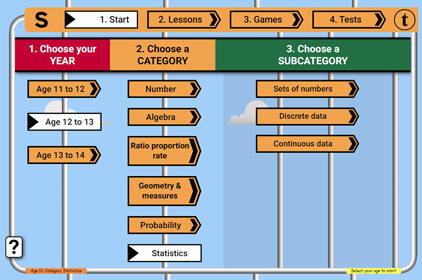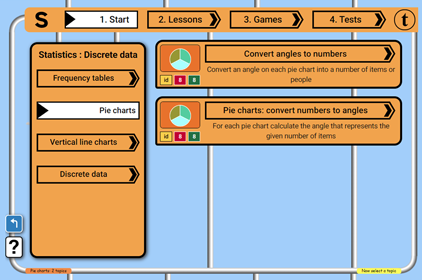


8th grade Number topics for Secondary math learners
| Topic icon key | ||
eq | Equation | Each item in the topic is in the form of an equation |
id | Identify | Each item in the topic is a thing |
mi | Missing item | Each item in the topic is a statement with a missing term |
10 | Number of items | There are 10 items in this topic |
8 | Extended items | Additional questions for games and tests in this topic |
Our math topics for 8th grade learners are designed to follow closely the Common Core standards for math for 8th grade pupils.
Number syllabus for 8th grade
Here are some key aspects of the math curriculum for Number for students aged 13 to 14:
Rational Numbers: Students further explore rational numbers, including fractions, decimals, and integers. They extend their skills in performing operations with rational numbers and apply them to solve real-world and mathematical problems. They deepen their understanding of the relationships between different types of rational numbers.
Irrational Numbers: Students are introduced to irrational numbers, such as the square root of non-perfect square numbers and pi. They explore the concept of irrational numbers and their decimal representations. They learn about the properties of irrational numbers and their relationship with rational numbers.
Exponents and Scientific Notation: Students extend their knowledge of exponents and scientific notation. They explore larger and smaller numbers and learn to express them using powers of 10 and scientific notation. They perform operations with numbers in scientific notation and apply them to solve problems involving very large or very small quantities.
Order of Operations: Students reinforce their understanding of the order of operations in more complex expressions. They apply the rules of parentheses, exponents, multiplication, division, addition, and subtraction to solve numerical and algebraic expressions. They explore the concept of nested parentheses and apply the order of operations to simplify expressions.
Factors and Multiples: Students further explore the concepts of factors and multiples. They learn to find prime factors, use factor trees, and calculate the greatest common factor (GCF) and least common multiple (LCM) of numbers. They apply these concepts to solve problems involving divisibility, prime factorization, and number patterns.
Proportional Relationships: Students delve deeper into proportional relationships. They explore direct and inverse proportionality and apply them to solve problems involving rates, scale factors, and proportional reasoning. They analyze graphs, tables, and equations to understand and interpret proportional relationships.
Prime Numbers and Composite Numbers: Students continue to explore prime numbers and composite numbers. They learn to identify prime numbers and understand the concept of prime factorization. They analyze the properties of prime numbers and composite numbers and apply them in various mathematical contexts.
Number Systems: Students are introduced to different number systems beyond the integers. They explore rational and irrational numbers, as well as different bases, such as binary and hexadecimal. They learn to convert numbers between different bases and apply these concepts to solve problems.
Mathematical Notation and Symbols: Students develop their skills in understanding and using mathematical notation and symbols. They learn to interpret and write mathematical expressions, equations, and inequalities. They use appropriate mathematical symbols and language to communicate their reasoning and solutions effectively.
Problem-Solving and Mathematical Reasoning: Students engage in complex problem-solving tasks that require critical thinking, mathematical reasoning, and creative approaches. They apply their number skills in real-world scenarios and mathematical contexts, making connections between different areas of mathematics. They communicate their solutions clearly, using mathematical language, notation, and justifications.
Throughout the curriculum, students engage in hands-on activities, mathematical investigations, and problem-solving tasks to reinforce their understanding of numbers. They develop their skills in computation, estimation, logical reasoning, mathematical modeling, and mathematical communication.
Multiples Factors Primes topics for 8th grade
8th grade → Number → Multiples Factors Primes → Multiples
Identify multiples of numbers to 12
Identify multiples of numbers up to 12
LCM using product notation
Identify the lowest common multiple (LCM) of 2 numbers using product notation
8th grade → Number → Multiples Factors Primes → Factors
HCF using product notation
Identify the Highest Common Factor (HCF) using product notation for the given pairs of numbers
8th grade → Number → Multiples Factors Primes → Primes
Prime factors
Identify the prime factors of each given number using product notation
8th grade → Number → Multiples Factors Primes → Standard form
Standard form: largest number
Compare numbers in standard form and identify the largest
Standard form: smallest number
Compare numbers in standard form and identify the smallest
Standard form: add and subtract
Add or subtract numbers in standard form
Standard form: multiply and divide
Multiply or divide numbers in standard form
A topic is selected at the beginning of a session at Free Math Games and will be remembered when you move between games or activities. The math for the topic is carefully constructed to match the level of difficulty taught in US schools. This means that you as a secondary pupil should see similar math problems to those you are seeing at school (if you are at school) for any particular subject. Please let us know if that is not the case.
See the help box below for instructions on choosing a topic here at Free Math Games.
UXO * Duck shoot * The frog flies * Pong * Cat and mouse * The beetle and the bee
Rock fall * Four in a row * Sow grow * Choose or lose * Mix and match

















